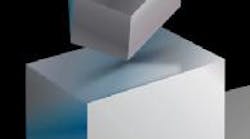A new EDM adaptive control manipulates jump-function motion to automatically push and pull sludge away in no-flush situations.
With conventional adaptive control systems, operators manually program electrode jumps.
For no-flush situations, Fuzzy Pro II automatically triggers a new jump function strategy that creates flushing actions to evacuate sludge.
Mitsubishi's machine hardware evaluates a spark generation, makes necessary adjustments, and passes the information to the Fuzzy Pro II adaptive control.
Most shops would rather run sinker EDMs with-flush and still be able to burn any type of part efficiently. With this in mind, one EDM manufacturer has re-evaluated the conventional jump function and developed a system that doesn't require an outside flushing device or drilling holes for through-the-electrode flushing.
Mitsubishi's new adaptive control, Fuzzy Pro II, automatically initiates a jump strategy that creates a flushing action from the up-and-down motion of the jump function. This action, pressure and vacuum, pushes or pulls sludge away from the burn gap.
The strategy increases jump-up distance and acceleration/deceleration rates to produce a high-speed jump. Through hardware monitoring and fuzzy-inference analysis, each jump is tailored to present burn conditions for the best balance between sludge production and removal.
Sludge
Basic designs of manual and some CNC EDMs do not intend the jump function to be used as a flush method. Conventional jump functions simply move electrodes in and out of the cut to give separate flushing methods time to work. Under certain conditions, electrodes erode workpiece material faster than sludge particles are removed from the cavity. Without jump, growth can occur, which is accumulated sludge in the cavity that heats up and attaches to graphite electrodes. The result could be a DC arc.
Operators using conventional systems manually program jumps to go up for a certain amount of time and then come back down. They must draw upon their own experience to adjust for a complicated, no-flush burn.
Mitsubishi's machine hardware evaluates one spark generation, determines a stability level, and makes an immediate adjustment if necessary. It then passes the information to the adaptive control which analyzes occurring trends and, if necessary, activates the jump function. According to the manufacturer, the new function manipulates the three elements in sludge removal—jump speed, jump-up distance, and jump-down time.
Using a nonlinear acceleration and decelaration jump-speed curve, Fuzzy Pro II monitors sludge production and removal. It then adjusts jump-up and jump-down parameters to optimize the discharge process.
A jump-up parameter defines a set distance that the electrode is retracted from the cut. Increasing this parameter produces greater flushing action.
Jump down determines the time duration of electrical-dis-charge pulses, which lengthens as flushing conditions improve.
Once these parameters are set, most conventional jump strategies will do well under normal flushing conditions. But, in situations when electrode geometries trap sludge or burning with a small undersize, the best method is through-the-electrode flushing. The drawback, says Brad Thalacker, general manager of Mitsubishi's NC-EDM R& D group, is that a shop can spend hundreds of hours just drilling holes in electrodes.
In the past, efficient no-flush burning was not an option. Mitsubishi's new control gives users the no-flush option and circumvents electrode-manufacturing bottlenecks. However, says Thalacker, a trade-off in burn time should be expected.
Hydraulic force compensation
Hydraulic forces produced by conventional jump strategies can be, in certain situations, damaging—typically when electrode size exceeds 2 in. 2 and at fine-finish settings where cut gaps are as small as 0.0005 in.
Vacuum and pressure forces exceeding 1 kg/cm 2 can distort the electrode or stress the machine casting itself. The results are shallow machining depths, gap instability, and long machining times. Fuzzy Pro II automatically eases hydraulic forces by varying the acceleration and deceleration rates of the jump. Signals used
for inference in the Fuzzy control system monitor force levels during actual discharge and trigger the adjustments.











